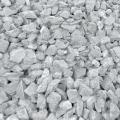How many kg are there in a cube of crushed stone?
Crushed stone is a material of natural origin, actively used in construction for filling roads, all kinds of sites, paving, and pouring various objects with concrete.
It is a bulk building material that is usually sold by weight. Regardless of the scale of the work being carried out, in order to ensure a sufficient amount of this material at the construction site, it is necessary to calculate in advance the volume of supplies, namely the amount of crushed stone in tons.
How to find out how many kilograms are in a cube of crushed stone?
To find out how much material is needed to fill an area of a certain area, proceed according to the following algorithm:
1. decide on the thickness of the layer;
2. knowing the area of the site and the height of the backfill, calculate the volume of the embankment in cubic meters;
3. Knowing how much crushed stone is in 1 m3, calculate the weight of the required batch.

But it's not that simple. The fact is that reliable calculations can be made only taking into account the characteristics of the material. Let's try to figure out what exactly can affect the weight of a cubic meter of crushed stone.
Factors influencing the specific gravity of crushed stone
Crushed stone is obtained from rocks by crushing them, so the properties of different types of crushed stone can differ significantly.
The most important characteristics that can affect the specific gravity of crushed stone are:
Type of rock used as the main material for the production of crushed stone;
place and conditions of production;
storage conditions;
size of the fraction obtained as a result of crushing;
crushed stone form;
water absorption of the manufacturing material;
humidity.

Depending on the properties of the manufacturing material, the weight of a cubic meter can differ by hundreds of kilograms. You can compare the weight of crushed stone from different materials using the following data on the number of tons in one cubic meter (t/m3):
Granite – 1.32-1.39
natural – 1.35
color – 1.7
sandstone – 1.3
construction – 1.36
from natural stone – 1.24-1.53
concrete – 1.7
limestone – 1.26-1.32
dolomite – 1.3
gravel – 1.32-1.45
slag – 1.0-1.5
marble – 1.5
marble according to GOST 8267-93 – 2.65
quartzite – 1.55-1.75
brick – 1.25-1.275
tuff – 0.8
from light shell rock – 0.6-1.8
rubble – 1.4-1.6
from ceramic cullet – 1.2-1.35
expanded clay – 0.25-0.6
aerated concrete – 0.4-0.6
chalk – 1.2
This is not the entire list of materials used for the production of crushed stone. Using similar tables given in reference books and on specialized websites, you can find out approximate data on how many kg of crushed stone are in a cube. But it should be understood that these data are very approximate. The value in each specific case may vary depending on the fraction, shape, porosity and moisture content of the material.
The size and shape of crushed stone affect the filling of the volume. For example, cube-shaped crushed stone has a high degree of compaction, while lamellar and needle-shaped types of crushed stone form many voids, which means the weight of such material will be lower compared to other types.

Water absorption of crushed stone is a property of the manufacturing material, which depends on the number and size of pores. Depending on this, dry or wet material will have different weight. The higher the water absorption value, the greater this difference will be.
The size of the fraction also makes its own adjustments to the calculations. A cubic meter of finer crushed stone will weigh more than similar material crushed into large pieces.
Principles for accurately calculating the weight of a batch of crushed stone
An exact answer to the question of how many m3 in a ton of crushed stone can only be found if you have information about the material specified in GOST for its manufacture or accompanying documentation for the batch.
When calculating the weight of a batch, data on the properties of crushed stone are used, such as
average density,
voidness of the fraction,
fullness,
bulk density.
The calculation procedure will be as follows:
1. knowing the emptiness of a particular fraction, they find fullness;
2. Multiplying the fullness by the average density to find the bulk density.
3. Knowing the bulk density, find the number of tons of crushed stone contained in a batch of a certain volume.
Let's try to calculate the weight of a batch of granite crushed stone with a volume of 5 cubic meters.
1. With a void fraction of 5-20 mm equal to 43%, the fullness will be 57%.
2. Then, with an average density of granite crushed stone of 2,600 t/m3, the bulk density can be found as follows:
2.600*0.57=1.482 kg/m3.
3. This means that for backfilling with a volume of 5 m3 you will need
1.482*5=7.410 tons of material.
If the bulk density is indicated in the accompanying documentation, it is even easier to find the weight of the batch. To do this, simply multiply the bulk density value by the volume in cubic meters.
Often, average bulk density values are used in calculations. A certain error depends on the ability of the material to absorb moisture, compaction during transportation or storage, and the shape of the crushed stone. That is why in accurate calculations a correction factor of 1.1 or 1.2 is used, depending on the properties of the material and its storage conditions.

Accurate calculations are used for serious construction work and the use of large volumes of crushed stone. For private construction, the above-mentioned characteristics of the material, and especially the correction factors, are rarely taken into account. You can always clarify the bulk density and approximate weight of a cubic meter of crushed stone from specialists when placing an order for delivery of the material. How many kg are there in a cube of crushed stone?
 Construction materials and list of works
Construction materials and list of works Proper insulation of a wooden ceiling in a private house
Proper insulation of a wooden ceiling in a private house What types of crushed stone are there?
What types of crushed stone are there?